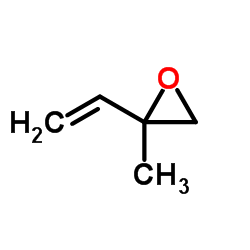UNII:O364AQJ1K5

UNII:O364AQJ1K5 structure
|
Common Name | UNII:O364AQJ1K5 | ||
|---|---|---|---|---|
| CAS Number | 1838-94-4 | Molecular Weight | 84.116 | |
| Density | 1.0±0.1 g/cm3 | Boiling Point | 78.7±9.0 °C at 760 mmHg | |
| Molecular Formula | C5H8O | Melting Point | N/A | |
| MSDS | Chinese USA | Flash Point | -7.8±0.0 °C | |
| Symbol |


GHS02, GHS07 |
Signal Word | Danger | |
|
The biotransformation of isoprene and the two isoprene monoepoxides by human cytochrome P450 enzymes, compared to mouse and rat liver microsomes.
Chem. Biol. Interact. 102(3) , 169-82, (1996) The metabolism of isoprene was investigated with microsomes derived from cell lines expressing human CYP1A1, CYP1A2, CYP2A6, CYP2B6, CYP2C9, CYP2D6, CYP2E1, or CYP3A4. The formation of epoxide metabolites was determined by gas chromatographic analysis. CYP2E1... |
|
|
Conjugation of isoprene monoepoxides with glutathione, catalyzed by alpha, mu, pi and theta-class glutathione S-transferases of rat and man.
Chem. Biol. Interact. 117(1) , 1-14, (1999) In the present study, the enzymatic conjugation of the isoprene monoepoxides 3,4 epoxy-3-methyl-1-butene (EPOX-I) and 3,4-epoxy-2-methyl-1-butene (EPOX-II) with glutathione was investigated, using purified glutathione S-transferases (GSTs) of the alpha, mu, p... |
|
|
Prediction of isoprene diepoxide levels in vivo in mouse, rat and man using enzyme kinetic data in vitro and physiologically-based pharmacokinetic modelling.
Chem. Biol. Interact. 138(3) , 247-65, (2001) The present study was designed to explain the differences in isoprene toxicity between mouse and rat based on the liver concentrations of the assumed toxic metabolite isoprene diepoxide. In addition, extrapolation to the human situation was attempted. For thi... |
|
|
DNA-damaging ability of isoprene and isoprene mono-epoxide (EPOX I) in human cells evaluated with the comet assay.
Mutat. Res. 629(1) , 7-13, (2007) Isoprene is produced in combustion processes and is widely used as an industrial chemical. It is a natural product emitted by plants and endogenously produced by humans and other mammals. Therefore, exposure to isoprene from both endogenous and exogenous sour... |